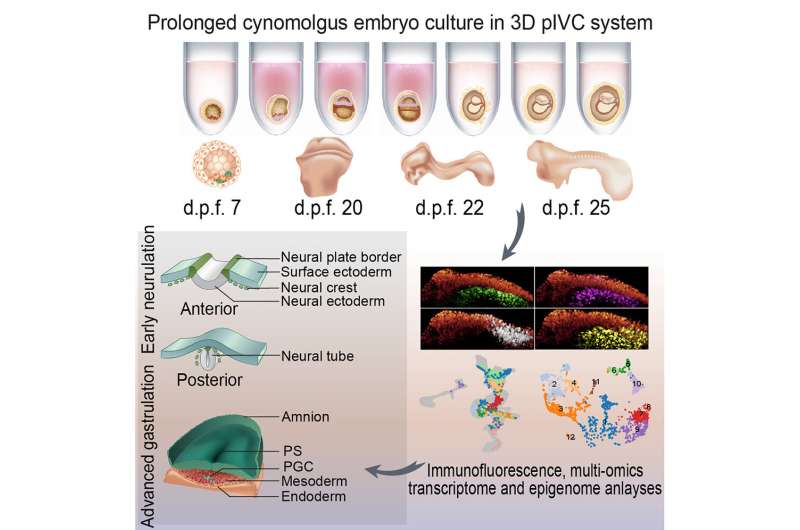May 15, 2023 report
This article has been reviewed according to Science X's editorial process and policies. Editors have highlighted the following attributes while ensuring the content's credibility:
fact-checked
peer-reviewed publication
trusted source
proofread
3D monkey embryos cultured in a lab offer unique insights into early development

Building on previous efforts to create a platform for the extended study of primate embryos in cell culture, two new reports from the State Key Laboratory of Primate Biomedical Research, Kunming University of Science and Technology in China, present a three-dimensional suspension structure that allows for more normal development and detailed observation of embryogenesis. The reports are published in Cell.
The first paper, "Neurulation of the cynomolgus monkey embryo achieved from 3D blastocyst culture," describes a study of gestational neurodevelopmental in a nonhuman model. The paper details a lab culturing system that allowed researchers to develop monkey embryonic cells from the blastocyst stage to the neurula stage at day 25 post-fertilization. The researchers then used this model to investigate neural tube development.
Neural tube defects (NTDs) are globally common birth defects of the brain, spine or spinal cord that present in fetuses within the first month of pregnancy. NTDs are strongly linked to folate (folic acid) deficiency, which is why folate supplements are commonly recommended before and during pregnancy.
While correlative relationships are known, the mechanisms of neurulation remain hidden mainly due to prohibitions on human embryo research and limitations of available model systems. This is true of many developmental stages and pathologies that could be studied with human embryonic tissues.
Working with macaque monkey embryos, the researchers established a three-dimensional prolonged in vitro culture (pIVC) system to study embryo development from seven to 25 days post-fertilization.
Through single-cell multi-omics analyses, the study demonstrates that pIVC embryos form three germ layers, including primordial germ cells, and establish proper DNA methylation and chromatin accessibility through advanced gastrulation stages. In addition, immunofluorescence confirmed neural crest formation, neural tube closure, and neural progenitor regionalization.
The transcriptional profiles and morphogenetics of these pIVC embryos resemble key features of similarly staged in vivo macaque and human embryos. With this non-human primate model, researchers can further investigate the mechanisms operating on NTDs in embryogenesis through advanced gastrulation and early neurulation and apply other research targets to the model system.
In the second paper, "Ex utero monkey embryogenesis from blastocyst to early organogenesis," researchers at Kunming University used the same lab-based culturing platform to track other developmental milestones during the third and fourth weeks of pregnancy, culminating in the formation of ectoderm, mesoderm, endoderm and the initial formation of various organs.
Previous non-three-dimensional cultivation of embryonic tissues failed to allow for early organogenesis, as the cell structures would collapse as soon as they began forming. According to the authors, "Ex utero monkey embryogenesis offers an easily accessible, tractable, and perturbable platform to dissect key developmental events beyond gastrulation stages in primates."
The researchers of the second study call the embedded 3D culture system the Enhanced Monkey Ex Utero Culture (EMEUC) system. This system used Geltrex and Matrigel for mechanical support and glucose as an additional energy supply. These optimizations helped maintain the structural integrity of monkey embryos during extended culturing and allowed the tissue to form most of the expected features compared to in vivo formation.
The next step will be to add agitated motion to the model to see if they can further improve developmental stage formations by better simulating a natural environment.
The 14-day rule
Current research on human embryos is limited to the first 14 days or less, depending on the state of development. The specific legal and regulatory language can differ (gastrulation, formation of the primitive streak, 14 consecutive days) depending on where the research occurs, though it all amounts to the same limit.
The method used in the studies offers researchers a potential workaround for studying human development with a platform of embryogenesis in primates. It will be possible to track the movements, organization and lineages of the embryonic cells late into development, which may have enough conservation with human embryogenesis to act as a research proxy.
The combined implication of the current papers is that of a lab-based workaround that may be the best non-human primate analog model currently available to study early embryonic development, as well as a platform that is prepared to make future research on human embryos more efficient, especially if the 14-day rule is ever reconsidered or replaced with something more conducive to solving the mysteries of developmental pathologies.
More information: Jinglei Zhai et al, Neurulation of the cynomolgus monkey embryo achieved from 3D blastocyst culture, Cell (2023). DOI: 10.1016/j.cell.2023.04.019
Yandong Gong et al, Ex utero monkey embryogenesis from blastocyst to early organogenesis, Cell (2023). DOI: 10.1016/j.cell.2023.04.020
Journal information: Cell
© 2023 Science X Network




















